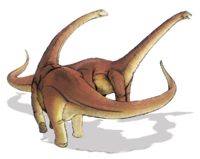Alamosaurus
2008/9 Schools Wikipedia Selection. Related subjects: Dinosaurs
| Alamosaurus Fossil range: Late Cretaceous |
||||||||||||||||||||||
|---|---|---|---|---|---|---|---|---|---|---|---|---|---|---|---|---|---|---|---|---|---|---|
 |
||||||||||||||||||||||
| Scientific classification | ||||||||||||||||||||||
|
||||||||||||||||||||||
| Binomial name | ||||||||||||||||||||||
| Alamosaurus sanjuanensis Gilmore, 1922 |
Alamosaurus, (pronounced /ˌæləməˈsɔrəs/; meaning "Alamo lizard"), is a genus of titanosaurian sauropod dinosaur from the Late Cretaceous Period of what is now North America. It was a large quadrupedal herbivore, up to 53 feet (16 meters) in length and up to 33 tons (30 metric tonnes) in weight. Alamosaurus, like other sauropods, had a long neck and a long tail, which may have ended in a 'whiplash' structure.
Naming
Contrary to popular assertions, this dinosaur is not named after the Alamo in San Antonio, Texas, or the battle that was fought there. The holotype, or original specimen, was discovered in New Mexico and, at the time of its naming, Alamosaurus had not yet been found in Texas. Instead, the name Alamosaurus comes from Ojo Alamo, the former name for the geologic formation in which it was found (that part of the Ojo Alamo Formation has since been reassigned to Kirtland Shale) and which was, in turn, named after the nearby Ojo Alamo trading post. The term alamo itself is a Spanish word meaning "poplar" and is used for the local subspecies of cottonwood tree. The term saurus is derived from saura (σαυρα), Greek for "lizard" and is the most common suffix used in dinosaur names. There is one species (A. sanjuanensis), which is named after San Juan County, New Mexico, where the first remains were found. Both genus and species were named by Smithsonian paleontologist Charles W. Gilmore in 1922.
Classification
Alamosaurus is undoubtedly a derived member of Titanosauria, but relationships within that group are far from certain. One major analysis unites Alamosaurus with Opisthocoelicaudia in a subfamily Opisthocoelicaudinae of the family Saltasauridae (Wilson, 2002). A major competing analysis finds Alamosaurus as a sister taxon to Pellegrinisaurus, with both genera located just outside Saltasauridae (Upchurch et al., 2004). Other scientists have also noted particular similarities with the saltasaurid Neuquensaurus and the Brazilian Trigonosaurus (the "Peiropolis titanosaur") which is used in many cladistic and morphologic analyses of titanosaurians (Lehman and Coulson, 2002).
History of discovery
Alamosaurus remains have been discovered throughout the southwestern United States. The holotype was discovered in the Lower Kirtland Formation of New Mexico and, since then, Alamosaurus has also been found in the upper part of the Kirtland, a formation which was deposited during the Maastrichtian stage of the Late Cretaceous Period and is commonly known as the "Kirtland Shale." Bones have also been recovered from other Maastrichtian formations, like the North Horn Formation of Utah and the Black Peaks, El Picacho and Javelina Formations of Texas. These formations start around 74 million years ago and last right up to the end of the Cretaceous, 65 million years ago. Alamosaurus may have been one of the last dinosaurs to go extinct.
Gilmore originally described a scapula (shoulder bone) and ischium ( pelvic bone) in 1922. In 1946, he found a more complete specimen in Utah, consisting of a complete tail, a right forelimb complete except for the tips of the toes, and both ischia. Since then, many other bits and pieces from Texas, New Mexico, and Utah have been referred to Alamosaurus, often without much description. The most completely known specimen is a recently-discovered juvenile skeleton from Texas, which allowed educated estimates of length and mass (Lehman & Coulson, 2002).
No skull material is known, except for a few slender teeth, and no armor scutes have been reported, such as those found in other advanced titanosaurians like Saltasaurus.
Skeletal elements of Alamosaurus are among the most common Late Cretaceous dinosaur fossils found in the United States Southwest and are now used to define the fauna of that time and place. Other contemporaneous dinosaurs from that part of the world include tyrannosaurs, smaller theropods, Nodocephalosaurus, Parasaurolophus, Torosaurus and Pentaceratops, among others.
